Hao Peng
Beihang University
Generalization of RLVR Using Causal Reasoning as a Testbed
Dec 23, 2025Abstract:Reinforcement learning with verifiable rewards (RLVR) has emerged as a promising paradigm for post-training large language models (LLMs) on complex reasoning tasks. Yet, the conditions under which RLVR yields robust generalization remain poorly understood. This paper provides an empirical study of RLVR generalization in the setting of probabilistic inference over causal graphical models. This setting offers two natural axes along which to examine generalization: (i) the level of the probabilistic query -- associational, interventional, or counterfactual -- and (ii) the structural complexity of the query, measured by the size of its relevant subgraph. We construct datasets of causal graphs and queries spanning these difficulty axes and fine-tune Qwen-2.5-Instruct models using RLVR or supervised fine-tuning (SFT). We vary both the model scale (3B-32B) and the query level included in training. We find that RLVR yields stronger within-level and across-level generalization than SFT, but only for specific combinations of model size and training query level. Further analysis shows that RLVR's effectiveness depends on the model's initial reasoning competence. With sufficient initial competence, RLVR improves an LLM's marginalization strategy and reduces errors in intermediate probability calculations, producing substantial accuracy gains, particularly on more complex queries. These findings show that RLVR can improve specific causal reasoning subskills, with its benefits emerging only when the model has sufficient initial competence.
Adaptation of Agentic AI
Dec 22, 2025Abstract:Cutting-edge agentic AI systems are built on foundation models that can be adapted to plan, reason, and interact with external tools to perform increasingly complex and specialized tasks. As these systems grow in capability and scope, adaptation becomes a central mechanism for improving performance, reliability, and generalization. In this paper, we unify the rapidly expanding research landscape into a systematic framework that spans both agent adaptations and tool adaptations. We further decompose these into tool-execution-signaled and agent-output-signaled forms of agent adaptation, as well as agent-agnostic and agent-supervised forms of tool adaptation. We demonstrate that this framework helps clarify the design space of adaptation strategies in agentic AI, makes their trade-offs explicit, and provides practical guidance for selecting or switching among strategies during system design. We then review the representative approaches in each category, analyze their strengths and limitations, and highlight key open challenges and future opportunities. Overall, this paper aims to offer a conceptual foundation and practical roadmap for researchers and practitioners seeking to build more capable, efficient, and reliable agentic AI systems.
MixKVQ: Query-Aware Mixed-Precision KV Cache Quantization for Long-Context Reasoning
Dec 22, 2025Abstract:Long Chain-of-Thought (CoT) reasoning has significantly advanced the capabilities of Large Language Models (LLMs), but this progress is accompanied by substantial memory and latency overhead from the extensive Key-Value (KV) cache. Although KV cache quantization is a promising compression technique, existing low-bit quantization methods often exhibit severe performance degradation on complex reasoning tasks. Fixed-precision quantization struggles to handle outlier channels in the key cache, while current mixed-precision strategies fail to accurately identify components requiring high-precision representation. We find that an effective low-bit KV cache quantization strategy must consider two factors: a key channel's intrinsic quantization difficulty and its relevance to the query. Based on this insight, we propose MixKVQ, a novel plug-and-play method that introduces a lightweight, query-aware algorithm to identify and preserve critical key channels that need higher precision, while applying per-token quantization for value cache. Experiments on complex reasoning datasets demonstrate that our approach significantly outperforms existing low-bit methods, achieving performance comparable to a full-precision baseline at a substantially reduced memory footprint.
RAGFort: Dual-Path Defense Against Proprietary Knowledge Base Extraction in Retrieval-Augmented Generation
Nov 13, 2025Abstract:Retrieval-Augmented Generation (RAG) systems deployed over proprietary knowledge bases face growing threats from reconstruction attacks that aggregate model responses to replicate knowledge bases. Such attacks exploit both intra-class and inter-class paths, progressively extracting fine-grained knowledge within topics and diffusing it across semantically related ones, thereby enabling comprehensive extraction of the original knowledge base. However, existing defenses target only one path, leaving the other unprotected. We conduct a systematic exploration to assess the impact of protecting each path independently and find that joint protection is essential for effective defense. Based on this, we propose RAGFort, a structure-aware dual-module defense combining "contrastive reindexing" for inter-class isolation and "constrained cascade generation" for intra-class protection. Experiments across security, performance, and robustness confirm that RAGFort significantly reduces reconstruction success while preserving answer quality, offering comprehensive defense against knowledge base extraction attacks.
Do Not Merge My Model! Safeguarding Open-Source LLMs Against Unauthorized Model Merging
Nov 13, 2025Abstract:Model merging has emerged as an efficient technique for expanding large language models (LLMs) by integrating specialized expert models. However, it also introduces a new threat: model merging stealing, where free-riders exploit models through unauthorized model merging. Unfortunately, existing defense mechanisms fail to provide effective protection. Specifically, we identify three critical protection properties that existing methods fail to simultaneously satisfy: (1) proactively preventing unauthorized merging; (2) ensuring compatibility with general open-source settings; (3) achieving high security with negligible performance loss. To address the above issues, we propose MergeBarrier, a plug-and-play defense that proactively prevents unauthorized merging. The core design of MergeBarrier is to disrupt the Linear Mode Connectivity (LMC) between the protected model and its homologous counterparts, thereby eliminating the low-loss path required for effective model merging. Extensive experiments show that MergeBarrier effectively prevents model merging stealing with negligible accuracy loss.
RLVE: Scaling Up Reinforcement Learning for Language Models with Adaptive Verifiable Environments
Nov 10, 2025Abstract:We introduce Reinforcement Learning (RL) with Adaptive Verifiable Environments (RLVE), an approach using verifiable environments that procedurally generate problems and provide algorithmically verifiable rewards, to scale up RL for language models (LMs). RLVE enables each verifiable environment to dynamically adapt its problem difficulty distribution to the policy model's capabilities as training progresses. In contrast, static data distributions often lead to vanishing learning signals when problems are either too easy or too hard for the policy. To implement RLVE, we create RLVE-Gym, a large-scale suite of 400 verifiable environments carefully developed through manual environment engineering. Using RLVE-Gym, we show that environment scaling, i.e., expanding the collection of training environments, consistently improves generalizable reasoning capabilities. RLVE with joint training across all 400 environments in RLVE-Gym yields a 3.37% absolute average improvement across six reasoning benchmarks, starting from one of the strongest 1.5B reasoning LMs. By comparison, continuing this LM's original RL training yields only a 0.49% average absolute gain despite using over 3x more compute. We release our code publicly.
Executable Counterfactuals: Improving LLMs' Causal Reasoning Through Code
Oct 02, 2025Abstract:Counterfactual reasoning, a hallmark of intelligence, consists of three steps: inferring latent variables from observations (abduction), constructing alternatives (interventions), and predicting their outcomes (prediction). This skill is essential for advancing LLMs' causal understanding and expanding their applications in high-stakes domains such as scientific research. However, existing efforts in assessing LLM's counterfactual reasoning capabilities tend to skip the abduction step, effectively reducing to interventional reasoning and leading to overestimation of LLM performance. To address this, we introduce executable counterfactuals, a novel framework that operationalizes causal reasoning through code and math problems. Our framework explicitly requires all three steps of counterfactual reasoning and enables scalable synthetic data creation with varying difficulty, creating a frontier for evaluating and improving LLM's reasoning. Our results reveal substantial drop in accuracy (25-40%) from interventional to counterfactual reasoning for SOTA models like o4-mini and Claude-4-Sonnet. To address this gap, we construct a training set comprising counterfactual code problems having if-else condition and test on out-of-domain code structures (e.g. having while-loop); we also test whether a model trained on code would generalize to counterfactual math word problems. While supervised finetuning on stronger models' reasoning traces improves in-domain performance of Qwen models, it leads to a decrease in accuracy on OOD tasks such as counterfactual math problems. In contrast, reinforcement learning induces the core cognitive behaviors and generalizes to new domains, yielding gains over the base model on both code (improvement of 1.5x-2x) and math problems. Analysis of the reasoning traces reinforces these findings and highlights the promise of RL for improving LLMs' counterfactual reasoning.
Probing the Critical Point (CritPt) of AI Reasoning: a Frontier Physics Research Benchmark
Oct 01, 2025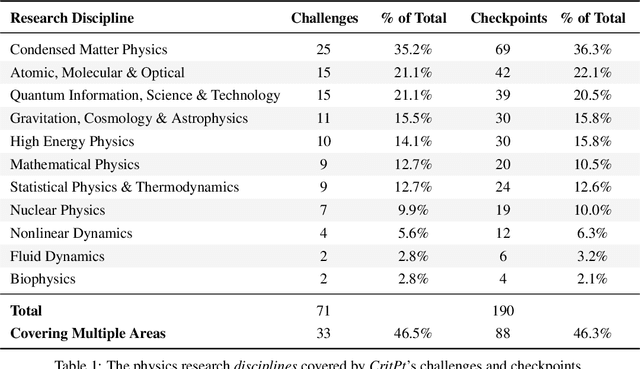
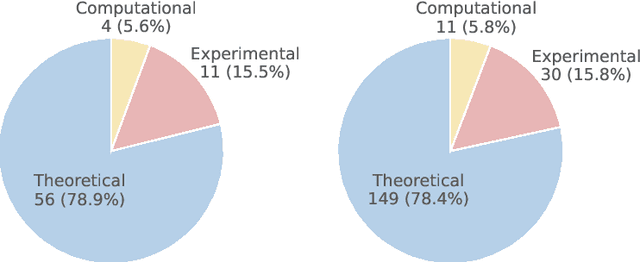
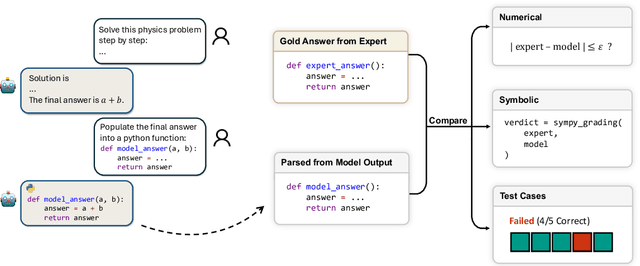
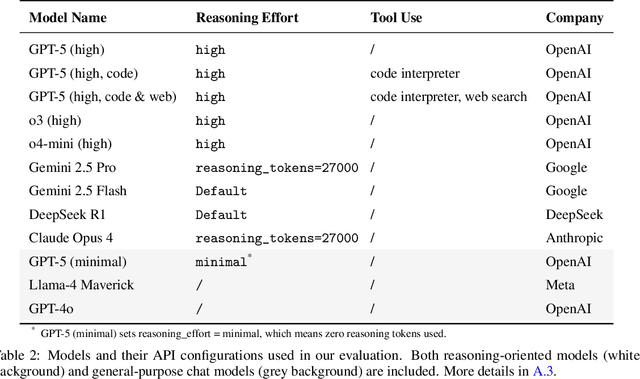
Abstract:While large language models (LLMs) with reasoning capabilities are progressing rapidly on high-school math competitions and coding, can they reason effectively through complex, open-ended challenges found in frontier physics research? And crucially, what kinds of reasoning tasks do physicists want LLMs to assist with? To address these questions, we present the CritPt (Complex Research using Integrated Thinking - Physics Test, pronounced "critical point"), the first benchmark designed to test LLMs on unpublished, research-level reasoning tasks that broadly covers modern physics research areas, including condensed matter, quantum physics, atomic, molecular & optical physics, astrophysics, high energy physics, mathematical physics, statistical physics, nuclear physics, nonlinear dynamics, fluid dynamics and biophysics. CritPt consists of 71 composite research challenges designed to simulate full-scale research projects at the entry level, which are also decomposed to 190 simpler checkpoint tasks for more fine-grained insights. All problems are newly created by 50+ active physics researchers based on their own research. Every problem is hand-curated to admit a guess-resistant and machine-verifiable answer and is evaluated by an automated grading pipeline heavily customized for advanced physics-specific output formats. We find that while current state-of-the-art LLMs show early promise on isolated checkpoints, they remain far from being able to reliably solve full research-scale challenges: the best average accuracy among base models is only 4.0% , achieved by GPT-5 (high), moderately rising to around 10% when equipped with coding tools. Through the realistic yet standardized evaluation offered by CritPt, we highlight a large disconnect between current model capabilities and realistic physics research demands, offering a foundation to guide the development of scientifically grounded AI tools.
Structural Information-based Hierarchical Diffusion for Offline Reinforcement Learning
Sep 26, 2025

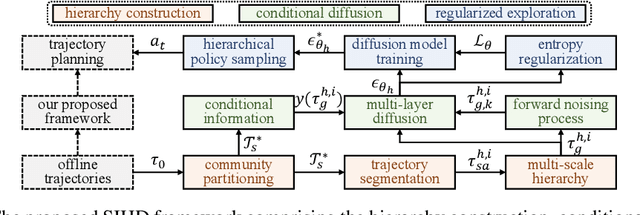

Abstract:Diffusion-based generative methods have shown promising potential for modeling trajectories from offline reinforcement learning (RL) datasets, and hierarchical diffusion has been introduced to mitigate variance accumulation and computational challenges in long-horizon planning tasks. However, existing approaches typically assume a fixed two-layer diffusion hierarchy with a single predefined temporal scale, which limits adaptability to diverse downstream tasks and reduces flexibility in decision making. In this work, we propose SIHD, a novel Structural Information-based Hierarchical Diffusion framework for effective and stable offline policy learning in long-horizon environments with sparse rewards. Specifically, we analyze structural information embedded in offline trajectories to construct the diffusion hierarchy adaptively, enabling flexible trajectory modeling across multiple temporal scales. Rather than relying on reward predictions from localized sub-trajectories, we quantify the structural information gain of each state community and use it as a conditioning signal within the corresponding diffusion layer. To reduce overreliance on offline datasets, we introduce a structural entropy regularizer that encourages exploration of underrepresented states while avoiding extrapolation errors from distributional shifts. Extensive evaluations on challenging offline RL tasks show that SIHD significantly outperforms state-of-the-art baselines in decision-making performance and demonstrates superior generalization across diverse scenarios.
Leveraging Support Vector Regression for Outcome Prediction in Personalized Ultra-fractionated Stereotactic Adaptive Radiotherapy
Sep 09, 2025Abstract:Personalized ultra-fractionated stereotactic adaptive radiotherapy (PULSAR) is a novel treatment that delivers radiation in pulses of protracted intervals. Accurate prediction of gross tumor volume (GTV) changes through regression models has substantial prognostic value. This study aims to develop a multi-omics based support vector regression (SVR) model for predicting GTV change. A retrospective cohort of 39 patients with 69 brain metastases was analyzed, based on radiomics (MRI images) and dosiomics (dose maps) features. Delta features were computed to capture relative changes between two time points. A feature selection pipeline using least absolute shrinkage and selection operator (Lasso) algorithm with weight- or frequency-based ranking criterion was implemented. SVR models with various kernels were evaluated using the coefficient of determination (R2) and relative root mean square error (RRMSE). Five-fold cross-validation with 10 repeats was employed to mitigate the limitation of small data size. Multi-omics models that integrate radiomics, dosiomics, and their delta counterparts outperform individual-omics models. Delta-radiomic features play a critical role in enhancing prediction accuracy relative to features at single time points. The top-performing model achieves an R2 of 0.743 and an RRMSE of 0.022. The proposed multi-omics SVR model shows promising performance in predicting continuous change of GTV. It provides a more quantitative and personalized approach to assist patient selection and treatment adjustment in PULSAR.
 Add to Chrome
Add to Chrome Add to Firefox
Add to Firefox Add to Edge
Add to Edge